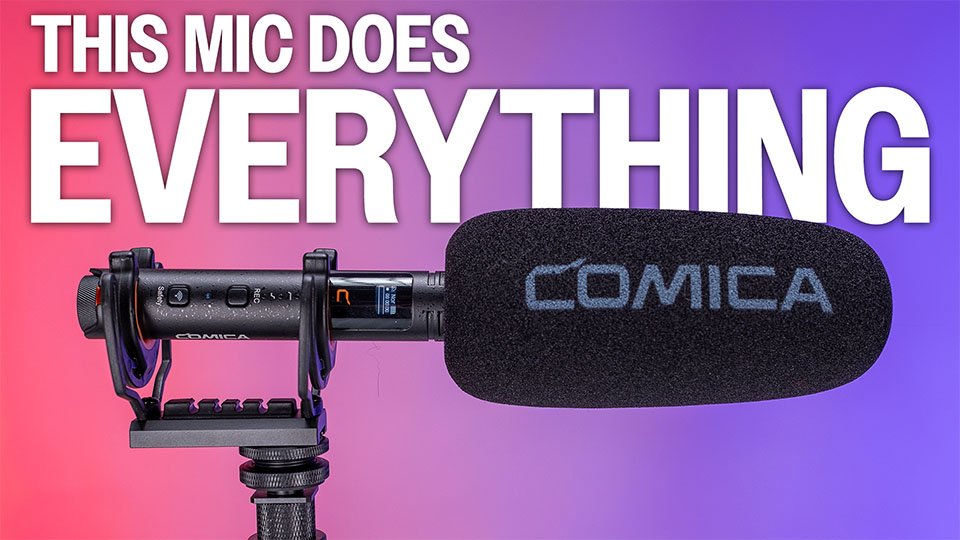Links in this post may be affiliate links. Any products purchased through affiliate links may provide a small commission which helps to support the SemiPro Tech+Gear site and YouTube channel.
In a market saturated with compact shotgun microphones, Comica stands out by merging wireless transmission, internal 32-bit float recording, and multiple output options into one highly adaptable microphone: the Comica VM40. Whether you’re a solo content creator, podcaster, or filmmaker, the VM40 aims to offer a do-it-all solution. But how does it really stack up—especially against a tried and true staple like the Rode VideoMic NTG?
For audio samples of all the VM40’s features, check out the embedded video below.
Comica VM40
MSRP: $249 USD
Pros
- True versatility – video dialog, narration, streaming, etc.
- Wireless connectivity simplifies your setup
- Internal 32-bit float recording
- Includes everything you need
- Fair price for the features offered
Cons
- Visual level meters on mic & receiver are not usable
- HPF isn’t very effective at reducing low frequency noise
- Non-replaceable internal battery
Best For: Content creators wanting a one-mic solution for multiple scenarios, or a simple setup with minimal wired connections.
Features & Specifications
The VM40 packs in a ton of features for the price. You can get the VM40 with one or two shotgun mic transmitters. The 2-microphone kit has an MSRP of $399. I tested the single microphone kit.
Here’s a rundown of the specifications:
- Polar Pattern: Supercardioid
- Frequency Response: 20Hz – 20kHz
- Self-Noise: 19dBA
- Max SPL: 130dB
- Outputs:
- 3.5mm analog
- USB-C (mic and receiver)
- Wireless (2.4GHz, to included receiver)
- Internal Recording:
- 32-bit float WAV
- 32GB built-in storage (~40 hours)
- Gain Dial: Stepless on-mic gain control
- On-Mic Controls: High pass filter (100Hz), High frequency boost, Start/Stop Recording
- Battery Life:
- Up to 32 hrs (3.5mm output)
- 10 hrs (wireless)
- 5 hrs (wireless + internal recording)
- Receiver Features:
- 8 hrs battery
- 3.5mm output and headphone monitoring
- Noise reduction (low/high)
- Gain control per channel
- Included Accessories:
- Shock mount (cold shoe + 3/8″ thread)
- Foam windscreen & fur windshield
- USB and 3.5mm cables
- Padded case
The VM40’s feature set make it not only usable, but helpful, in multiple content creation scenarios. Besides being able to use it in a traditional boom position without long cables (thanks to the wireless connection), it also works well in a close-up position for narration, podcasting, and general use cases like video calls or streaming. It worked well in all my testing scenarios, the one exception being long-distance wireless transmission (see the neutral section below for details).
How It Compares: Comica VM40 vs Rode VideoMic NTG
Because of its similar feature set and price, I can’t ignore the Rode VideoMic NTG which has been a great option for content creators since it was released. I provided comparison audio samples in the video above. It features the same $249 price, USB and 3.5mm outputs, an internal battery, and on-board mic setting control buttons. But there are a few distinctions:
What the VM40 adds:
- Wireless transmission with included receiver
- Internal 32-bit float recording
- Mobile app control via the receiver
- Dual-channel capability (stereo mode with two VM40 mics)
What the NTG offers instead:
- -20dB pad
- Dual HPF options (75Hz, 150Hz)
- Built-in DSP via Rode Connect app (over USB connection only)
- Lower self-noise at 15dBA vs 19dBA
You can simulate the VM40’s features on the NTG by adding a wireless mic kit like the Rode Wireless Pro, but the total cost could easily top $550 or more.
Let’s now consider the VM40 overall and its pros, neutral aspects, and cons. If you’re not familiar with my review style, neutral items are things that could be a pro or a con depending on your point of view, or may be just good things to know but don’t have definite positive/negative impacts.
Pros
- True versatility: Works as a traditional boom mic, a wireless solution, a USB mic, or a standalone recorder. A rare combination.
- 32-bit float internal recording: No need to worry about clipping audio, as long as you don’t exceed the max SPL of the mic capsule (130dB). Great for unpredictable sound levels and it can save you if you forget to adjust the gain on the receiver.
- Flexible power options: Up to 5 hours while recording internally + wirelessly is competitive for this class of gear.
- Smart portability: Eliminates the need for long cables or an external recorder, simplifying your setup (and teardown).
- Comprehensive package: Comes with everything needed, including mounting options, two windscreens, and a sturdy case.
Neutral
- Sound profile: Slightly muddy/boomy in close-mic setups on some voices, but cleanable with high pass filter and EQ. Others may find it perfectly fine out of the box.
- Self-noise: 19dBA is higher than the NTG and could be noticeable if you’re recording a voiceover in a dead quiet space, but I did not find it to be noticeable in real-world usage. If you’re recording outdoors there will nearly always be ambient sound greater than 19dBA.
- Noise reduction: Only applies to the wireless output—not internal or USB—so its use cases are limited. I also found the sound quality to be degraded significantly with the noise reduction turned on.
- Wireless range: Advertised 200m is optimistic. In breezy/windy outdoor conditions, signal stability can suffer past 50m. Still solid for typical 10–15m setups which covers most content creators. And you always have the internal recording.
- Fur windscreen performance: Effective under ~7mph winds. Struggles with stronger gusts, though I’ve found that to be common for included wind muffs with mic kits like this.
Cons
- Laggy and imprecise level meters: Both on the mic and receiver, the visual level meters are not usable. This may be able to be improved with a future firmware update, but in the meantime you’ll want to rely on external meters for reliable monitoring.
- High pass filter could be stronger: A single 100Hz filter with a gradual slope isn’t as flexible or effective as the NTG’s dual options. I found it to only remove a minimal amount of low frequency noise in my testing. It helps a little, but not a lot.
- Non-replaceable battery: Like most built-in battery designs, this limits long-term serviceability. The VM40 is hardly the only culprit of having a built-in battery that can’t be replaced by the owner, but nonetheless it still means that someday it will stop holding a charge and you’ll have to toss the whole unit.
Final Thoughts
The Comica VM40 is arguably the most flexible sub-$300 microphone currently available for content creators. No other shotgun mic at this price point offers this exact combination of USB, analog, wireless transmission, and internal 32-bit float recording. It’s not without a few quirks, but those are outweighed by the sheer functionality it delivers.
While Rode’s VideoMic NTG may offer cleaner audio out-of-the-box and a more useful HPF, the VM40 packs in more workflow options for the same price—especially if you don’t already own a wireless mic system or 32-bit recorder.
If you’re a solo creator looking for a one-mic-does-it-all solution, the VM40 is absolutely worth your consideration.


